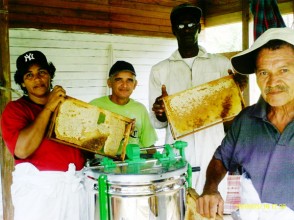Local apiculture expert and executive member of the Guyana Beekeepers Association Linden Stewart said the goal of Guyana becoming an exporter of honey to the Caribbean and further afield is still “some way off” but local conditions continue to hold promise for the success of the industry.
For much of this year, Stewart has been active in the sector, organising workshops and initiating bee projects in various communities in the rural and hinterland regions. Stewart said the projects, some of which have been funded by the Office of the Prime Minister and the ministries of Agriculture and Amerindian Affairs, are paving the way for the creation of a stronger apiculture sector that could make honey exports a reality in the foreseeable future.

The most recent statistics on the local beekeeping industry indicate that the sector comprises around 300 beekeepers who tend approximately 2,000 hives. Stewart said that at a local beekeeping forum in October, Agriculture Minister Robert Persaud had pointed to what he described as “the very small size of the industry given the extent of Guyana’s forested area which allows for the accommodation of approximately 17 million hives that could generate export revenue in excess of US$800 million.
Stewart told Stabroek Business that much of his own work this year had been focused on placing the industry on a firmer footing in some of the forested areas of the country and that the setting up of more than 200 hives in the Upper Mazaruni area had been one such project. He disclosed that one of the more recent successes of the local industry had been a
beekeeping project at Kamarang, initially sponsored by Prime Minister Samuel Hinds and which had now grown beyond the initial 30 hives. “I expect that we will see quantities of high-quality honey from Kamarang appearing on the urban market early next year. While it is nowhere near enough to meet the needs of the local market it is at least one success story that we can cite,” Stewart said.
Currently, Guyana imports an estimated 5,000 gallons of honey annually, most of which is used as a sweetener in the local beverage industry.
Stewart told Stabroek Business that efforts to strengthen the local honey industry coincide with a current global increase in honey production attributed to a general rise in living standards and an increased interest in natural and health products. International reports on the industry support Stewart’s assessment of the global honey industry with a specialist journal pointing out recently that worldwide honey consumption and consequently its production demand is increasing annually, and that there are no surplus global honey stocks. Natural disasters such as drought, flooding and fire have also taken their toll on the industry.
Stewart told Stabroek Business he believed that one of the first targets of the local industry in its push towards self sufficiency ought to be to seek to supply the approximately 5,000 gallons of honey imported into Guyana annually by Banks DIH Ltd to sweeten its beverages. “That is a visible target that we can aim at. Reaching the target of supplying all of the honey needs of the country’s biggest importer of the commodity is a means of helping us measure our success,” Stewart said.
Evaluation of the local bee-keeping industry has indicated that the country lacks the technical expertise to pursue the envisaged plans for its expansion. Stewart acknowledged that this was indeed a major problem, pointing out that working in the industry required a “certain level of competence.” Apart from the human resource challenges, there are also challenges associated with acquiring the technology necessary for running an efficient apiculture sector. In the latter regard Stewart is suggesting that there is “huge potential” for collaboration between Guyana and Brazil. He said that as one of the leading global sources of organic honey, Brazil can play a role in training local apiculture enthusiasts. Stewart pointed out that the acceleration of trade and commercial relations between Brazil and Guyana could embrace the apiculture industry since there were factors that encouraged such collaboration including the proximity of some of the country’s largest honey-bearing regions of Guyana to Brazil.
According to Stewart, remote hinterland areas with little alternative economic activity might find the apiculture industry particularly suited to their environment. “Some of these are densely forested areas that are heavily populated by bees. It really is a matter of getting the bees to work for you. That requires expertise, but the more we can build on our training and the setting up of hives the better the chance we have of meeting local demand then beginning to think of how we can supply the regional and international markets,” Stewart said.




